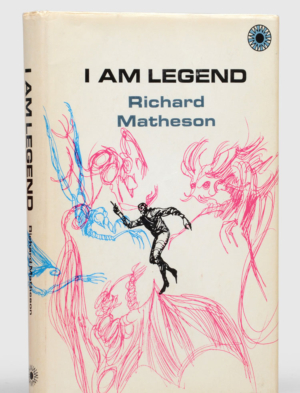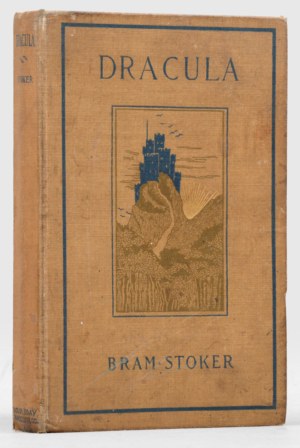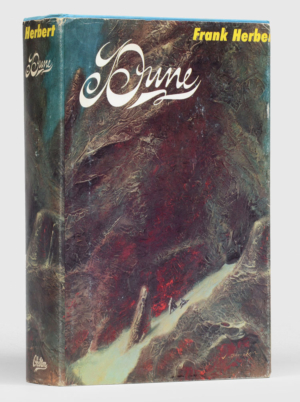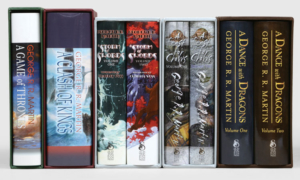Exploring the multiverse of science fiction and fantasy can be an exhilarating journey for a collector, and an inexhaustible one too. As well as all the celebrated 19th and 20th Century classics of the genre, from Frankenstein and Alice In Wonderland to Lord Of The Rings and Dune, it’s worth remembering that the roots of imaginative literature go deep. Great 18th or 17th Century works like Gulliver’s Travels or Paradise Lost can be seen through this lens – so too Shakespeare’s magical plays like The Tempest, or even Dante’s Divine Comedy.
And there couldn’t be a more timely moment to delve into fantasy literature. The world in recent months has shown that sometimes fact is stranger than fiction, and that works that may have seemed like acts of extraordinary imagination, have proved to be uncannily prophetic.
Apocalyptic and dystopian fiction
A rare first edition of Mary Shelley’s The Last Man – an early 19th-Century precursor to popular apocalyptic fiction that revolves around survivors of a global pandemic – was one of the highlights of Peter Harrington’s recently launched fantasy and sci fi catalogue In Other Worlds for good reason. Other examples in the ‘last man’ genre include Richard Matheson’s I Am Legend – the inspiration of several films, including the 2007 Hollywood production starring Will Smith.

Dystopian novels and works of apocalyptic fiction continue to capture the imagination of fans, collectors, and creatives – from scriptwriters to artists. When starting a collection you could begin by exploring well-known works such as George Orwell’s Nineteen Eighty Four, or Aldous Huxley’s Brave New World, or more obscure stories such as E. M. Forster’s ‘The Machine Stops’ (published in a 1928 collection entitled The Eternal Moment). Written in 1909, it imagines a future world in which humans, retreating from an uninhabitable earth, are confined to individual rooms and communicate with one another through electronic screens.
Beyond the realms of the normal
Gothic and supernatural horror is also a key area, and classics such as Anne Radcliffe’s Mysteries Of Udolfo or Horace Walpole’s Castle Of Otranto, or other tales of supernatural horror such as Bram Stoker Dracula or the works of H. P. Lovecraft are good places to come to grips with this genre. Sci-fi can be intergalactic, with core contributions by Robert Heinlein and Isaac Asimov, or cybernetic, such as William Gibson’s unmissable Neuromancer. Or it can even be wholly terrestrial though nonetheless outlandish, such as H. G. Wells’s ground-breaking The Time Machine. All these are seminal works, which continue to command interest whenever they come to the market.

Dreams and drug-induced fantasy
But the worlds of fantasy and sci-fi are, by their nature, limitless, and you can create your own collecting space by exploring more outré aspects of the literature, some of which might deviate from what most could consider to be within the traditional gamut of fantasy and sci-fi. Try the prophetic dreams of William Blake, or hallucinatory narcotic adventures like Hunter S. Thompsons Fear & Loathing In Las Vegas. These too are relevant to the heritage of imaginative literature, and hold testament to the imagining-power of the human brain.
Sci-fi in popular culture
Film and television dramas draw regularly from this genre – many of these have since gone on to become cult classics in their own right.
These include the Lord Of The Rings trilogy by Tolkien, the Star Wars film franchises and more recently the unprecedented success of HBO’s Game Of Thrones TV series. Rare and valuable editions of the books that inspired these popular phenomena are often extremely collectable, and their value can grow significantly in relation to their cult popularity – and in anticipation of the launches of new adaptations and seasons hitting cinemas and TV screens. Frank Herbert’s Dune, for example, often voted the greatest science-fiction novel of the 20th Century, and the subject of David Lynch’s bizarre cult film adaptation in the Eighties, is due a reboot later this year with a film starring Timothee Chalamet.

Imaginative creations that inspire generations
Nostalgia is also a powerful force, especially when it comes to collecting. Writers like J. M. Barrie, C. S. Lewis, or L. Frank Baum, are highly popular in their fantastical creations for children such as Peter Pan, The Wizard Of Oz, or the Narnia series. Collecting Narnia has a relatively inexpensive entry level, with the later titles in the series being more common – but a nice first edition of The Lion, The Witch, & The Wardrobe, can stretch into five figures.
Collections that tell a story – whether it’s about the books, the authors, or even about yourself – can start to develop unique and increasing value over time, in addition to offering many years of joy as you navigate your own personal collecting journey.
Some advice for first-time collectors of fantasy and sci-fi literature
Buy the best editions you can afford – The physical condition of a book plays a big role in its value as a collectable. Also, do not waste meaningful money on reprints – true collectable value generally rests in the first appearance in the world of the books people love.
Judge a book by its cover – 20th Century books, with some exceptions, should have their original dust jackets, and 19th Century and earlier books should ideally be in the original publisher’s bindings or boards, or in attractive and ideally contemporary custom bindings. Be wary of repair and restoration.
Do not buy any book which is incomplete, lacking pages or illustrations, or which is ‘ex-library’, with library stamps or lending labels.
Author’s signatures, or even full presentation inscriptions can immensely add to value – but be on your guard. Forgeries are common and it’s a good idea to look for longer inscriptions – which are less easy to fake – than just signatures. The best thing, of course, is a book meaningfully inscribed to someone interesting. A copy of H.G. Wells The First Men In The Moon, another example from our recent catalogue, is appropriately inscribed by the author: ‘To Miss Healey with kindest regards from H. G. Wells’. Elizabeth Healey was a fellow student of Wells at the Normal School (later Royal College) of Science, South Kensington, London, and a long-term friend and correspondent.
Work with trustworthy dealers who are ideally affiliated with trade organisations like ILAB, the ABAA, and ABA, which confer various guarantees and protections where it comes to authenticity.

Works by women or BAME authors, or indeed other increasingly topical genres such as climate fiction offer other exciting new opportunities for collectors in this genre. Carol F. Kessler’s Daring to Dream; Utopian Fiction By United States Women Before 1950, is one example, as is Rebecca M. Marrall’s Women Of Color In Speculative Fiction: An Annotated Bibliography Of Authors. On this topic, fantasy publishing history was made in recent years by African-American writer Nora K. Jemisin, whose Broken Earth trilogy 2015-2017 became the first to win the prestigious Hugo Award for best novel with each book in three sequential years.
Guides can provide inspiration on where to start and also provide notes on what to look out for. Some authoritative places to begin include: E. F. Bleiler’s Guide To Supernatural Fiction and two-part Science-Fiction bibliography, or Frank N. Magill’s Survey Of Modern Fantasy Literature. A Conversation Larger Than The Universe: Readings In Science Fiction And The Fantastic 1762-2017 by Henry Wessells is also highly enjoyable.
This above all: buy what you love. And find a bookseller you trust, and who shares your enthusiasm. You may even discover things you never knew you wanted.
More information on Peter Harington’s collection, In Other Worlds: Fantasy, Science Fiction, And Beyond can be found here.
